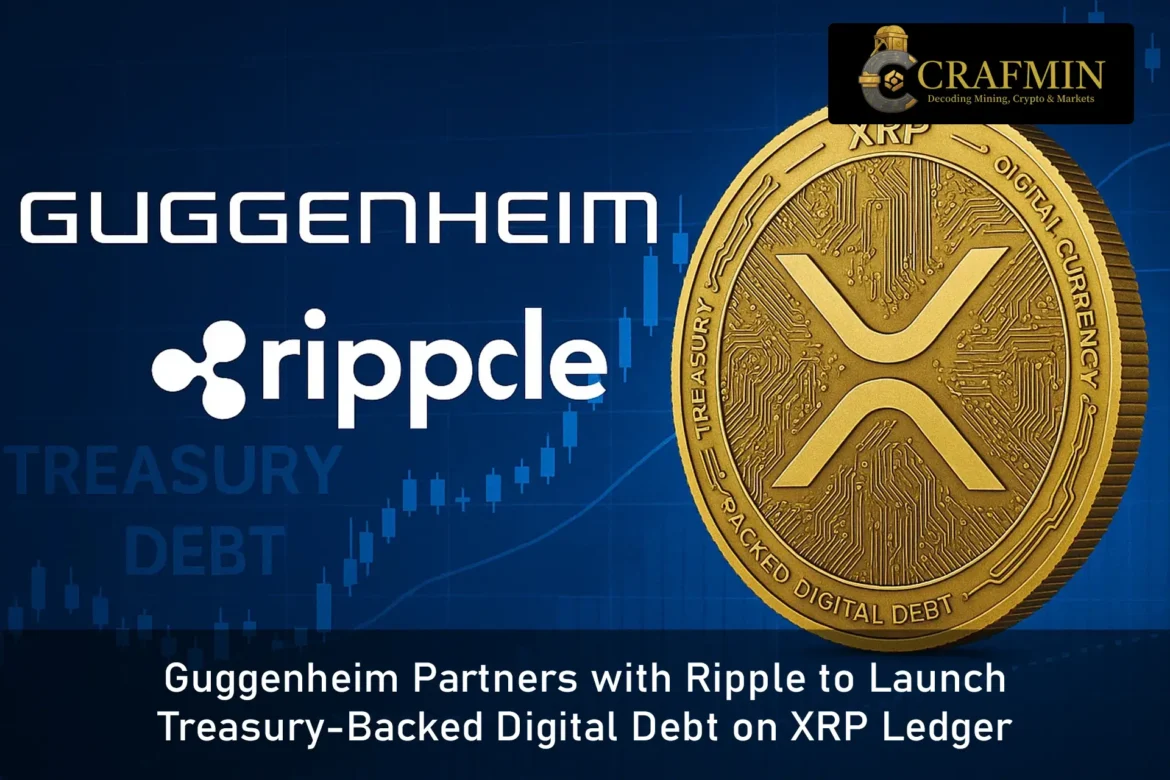Guggenheim Expands Digital Debt Initiative Through Ripple’s XRP Ledger
US investment group Guggenheim is widening its digital finance operations by linking up with Ripple. The collaboration brings a government-backed fixed-income product onto Ripple’s XRP Ledger, reflecting a stronger connection forming between established financial institutions and blockchain technology.
Guggenheim Treasury Services, a division of Guggenheim Capital, is leading the development. The firm is introducing a digital version of commercial paper—a short-term debt instrument—onto a blockchain system. This version is supported by United States Treasury securities, making it a low-risk option aimed at institutions seeking short-term returns.

Image 1: Guggenheim partners with Ripple (Source: X)
A Digital Shift in Fixed-Income Offerings
In traditional finance, commercial paper is used by companies to borrow money over short periods, usually without involving collateral. Guggenheim has adapted this model to operate on a digital platform, turning the paper into blockchain tokens that can be bought and traded more efficiently.
This shift reduces dependence on conventional intermediaries and enables round-the-clock transactions. Blockchain-based systems, such as XRP Ledger, allow financial instruments like these to be managed with quicker settlement times and significantly lower costs. This opens the door to broader market access and reduces delays associated with traditional banking processes.
As part of the arrangement, Ripple is backing Guggenheim’s digital commercial paper initiative with a $10 million investment. This capital injection is designed to accelerate the project and encourage institutional adoption of tokenised fixed-income products.
The asset in question has a maximum term of 397 days and is customisable based on investor needs. It is fully backed by U.S. Treasury notes, which ensures a high level of security and credibility in global markets. The product targets professional investors seeking regulated exposure through a modernised system.
Ripple’s Broader Role and RLUSD Integration
Ripple’s development team, known as RippleX, has also hinted that its own stablecoin may be used as a method of payment for these assets. The coin, named RLUSD, is pegged to the U.S. dollar and has maintained a consistent value since launching in December 2024. Its supply has already passed the $350 million mark, a sign of solid market uptake.
Markus Infanger, who heads innovation strategy at RippleX, indicated the intention to make this stablecoin available for purchasing Guggenheim’s debt product. This would allow users to engage in stable-value transactions without converting back into traditional currency, offering another step towards efficient digital settlement.
Guggenheim’s initiative builds on an earlier release from September 2024, when the firm introduced a similar commercial paper offering using the Ethereum blockchain. That debut marked Guggenheim’s first major step into tokenised finance, with approximately $20 million in assets allocated at the time.
Now, by embracing XRP Ledger, Guggenheim is expanding its approach. XRP Ledger provides a blockchain environment known for its fast processing times, low transaction fees, and energy efficiency. It also enables continuous operation, a key difference from traditional financial markets which operate within fixed hours.

Image 2 (Source: CryptoRank)
Tokenisation Gains Ground Among Institutions
The move by Guggenheim reflects a larger industry shift toward tokenising real-world assets. Financial services firms around the world are exploring how to transfer traditional investments—like bonds, loans, and managed funds—onto blockchain networks. This approach offers improvements in transparency, speed, and global accessibility.
Major players are already involved. BlackRock’s USD Institutional Digital Liquidity Fund, known as BUIDL, is one of the largest of these offerings and is managed in partnership with Securitize. The fund currently holds nearly $3 billion in tokenised Treasury securities and remains a leading example of real-world assets moving on-chain.
Other firms, including Franklin Templeton and Fidelity, are also using blockchain to bring traditional money market funds into the digital space. These offerings cater to institutional clients but pave the way for retail participation in the future.
The market isn’t limited to large investment houses. Newer entrants like Midas, a fintech firm from Germany, have launched tokenised government debt products with no minimum investment requirement. Their recent release, built on the Algorand blockchain, makes such instruments accessible to a broader audience without the entry barriers common in traditional finance.
Read Also: XRP Joins Nasdaq Crypto Index, Boosting Market Credibility and Institutional Trust
The platforms supporting these transitions are also attracting investment. Securitize, which works behind the scenes on tokenisation infrastructure, has raised funding from firms like Jump Crypto. Securitize now manages more than $4 billion in tokenised assets, helping financial institutions modernise how they issue and manage investments.

